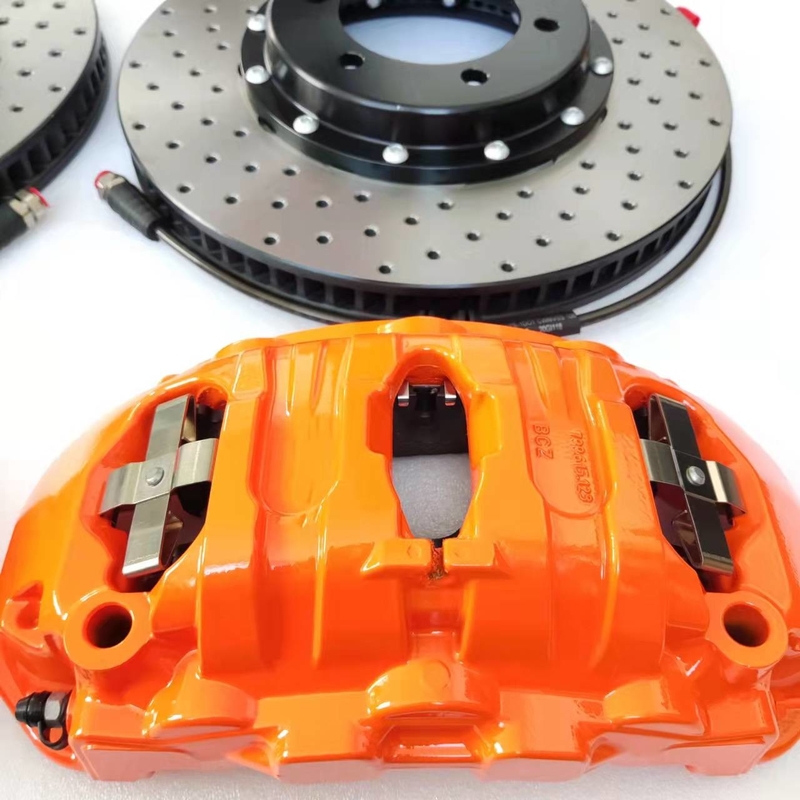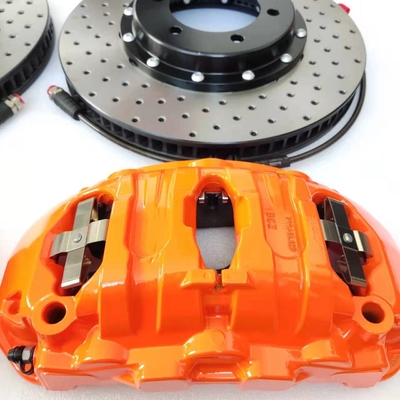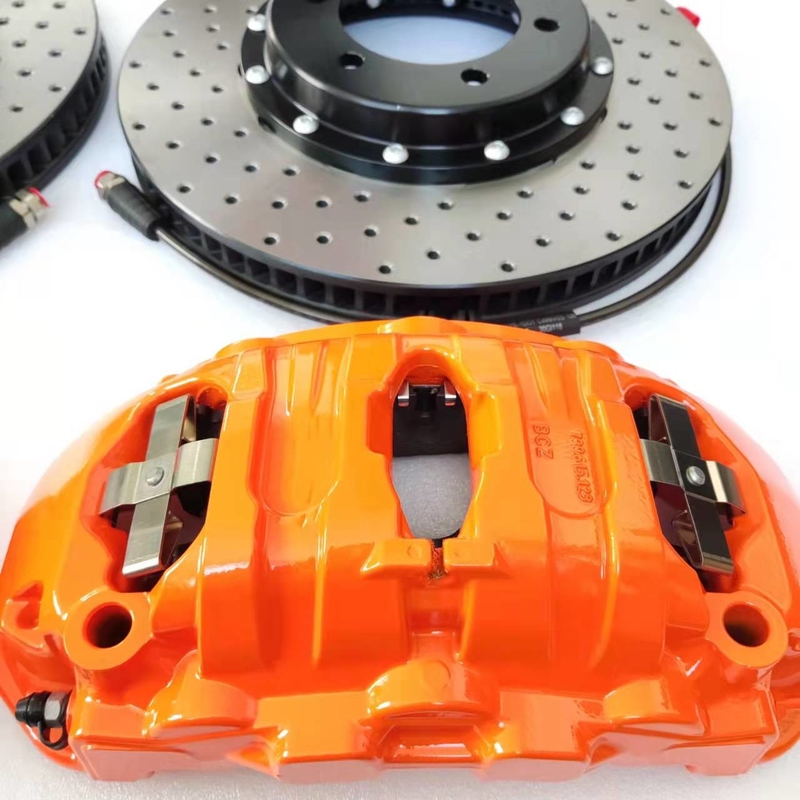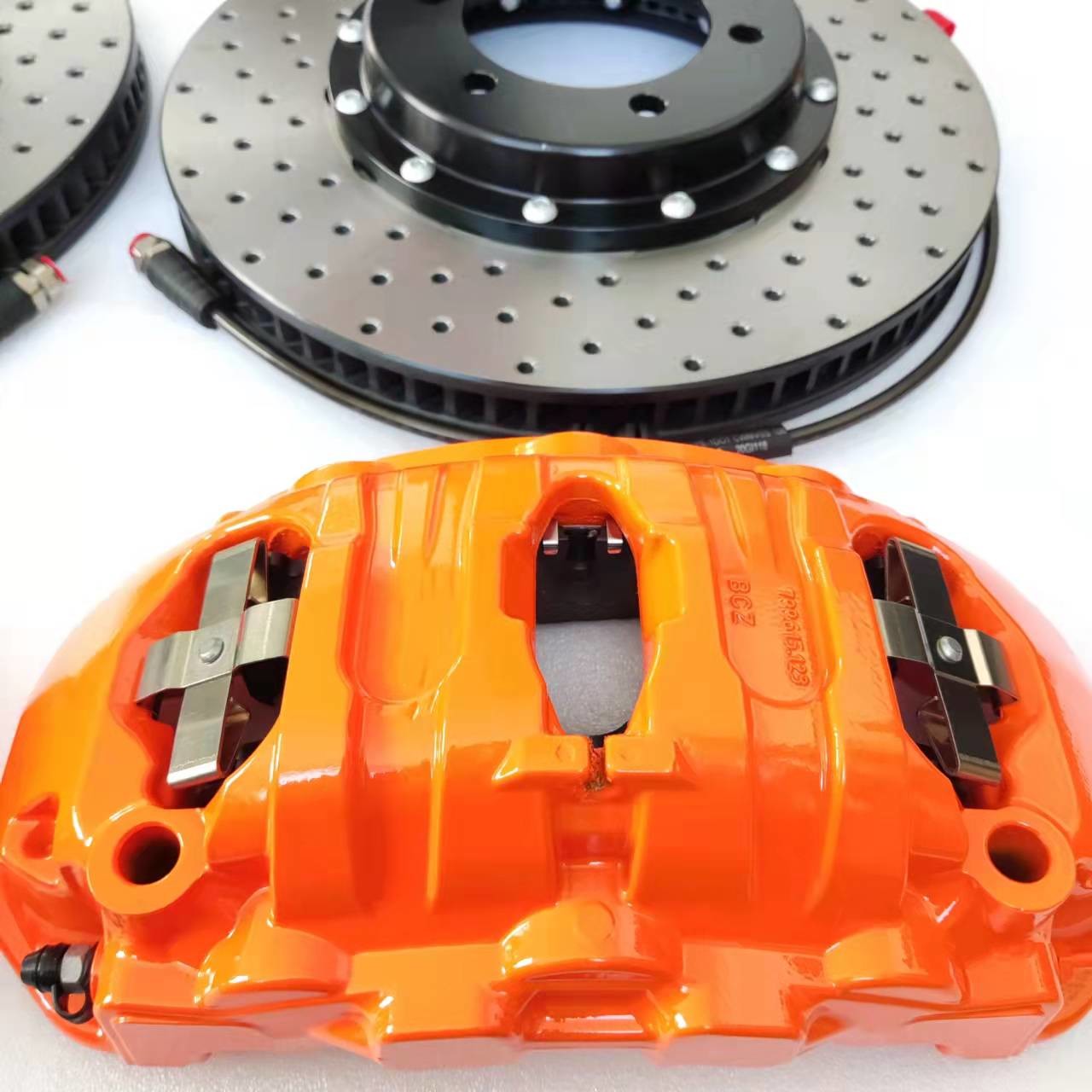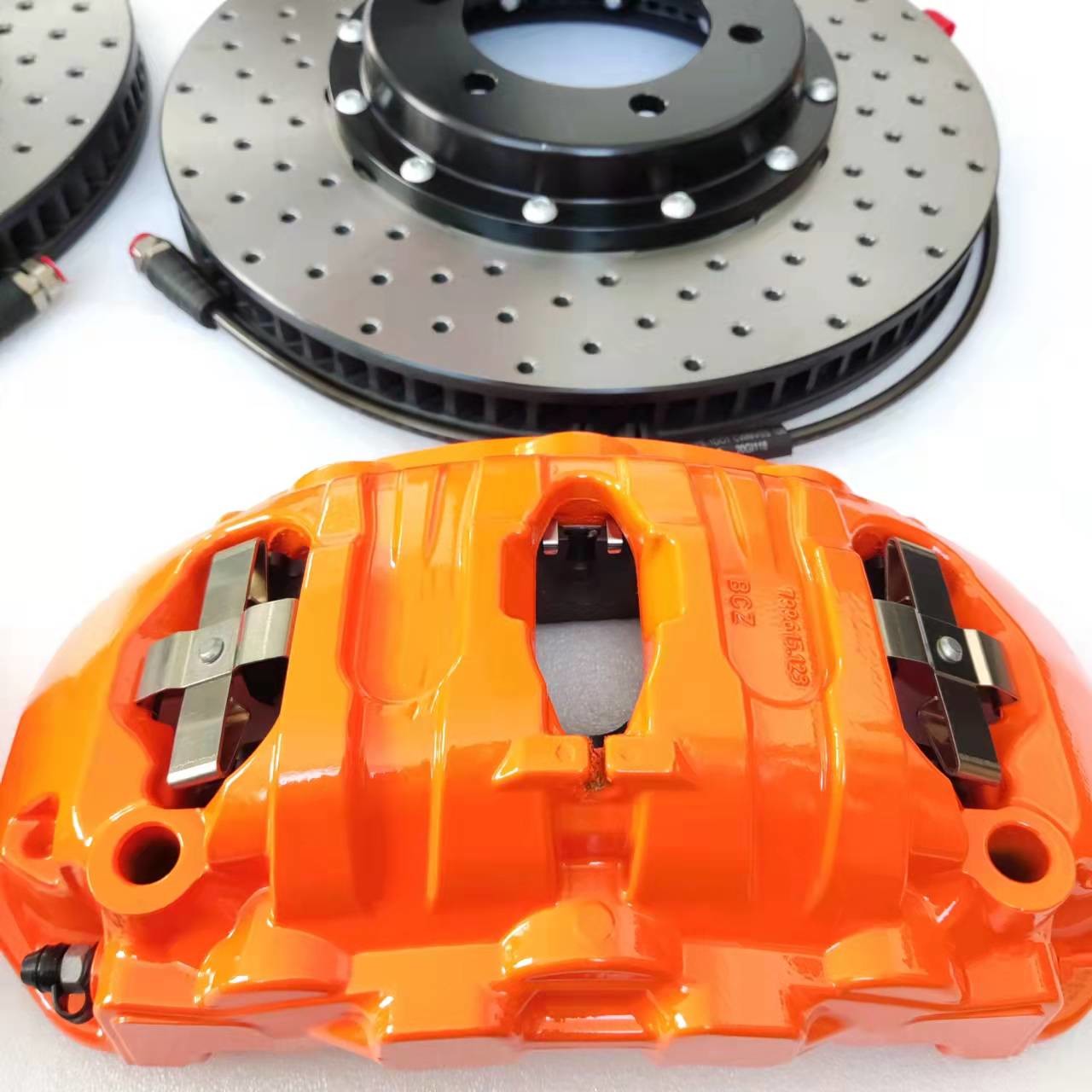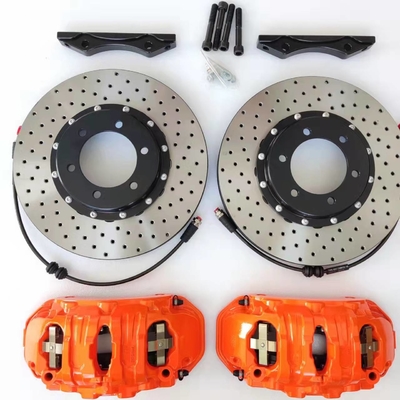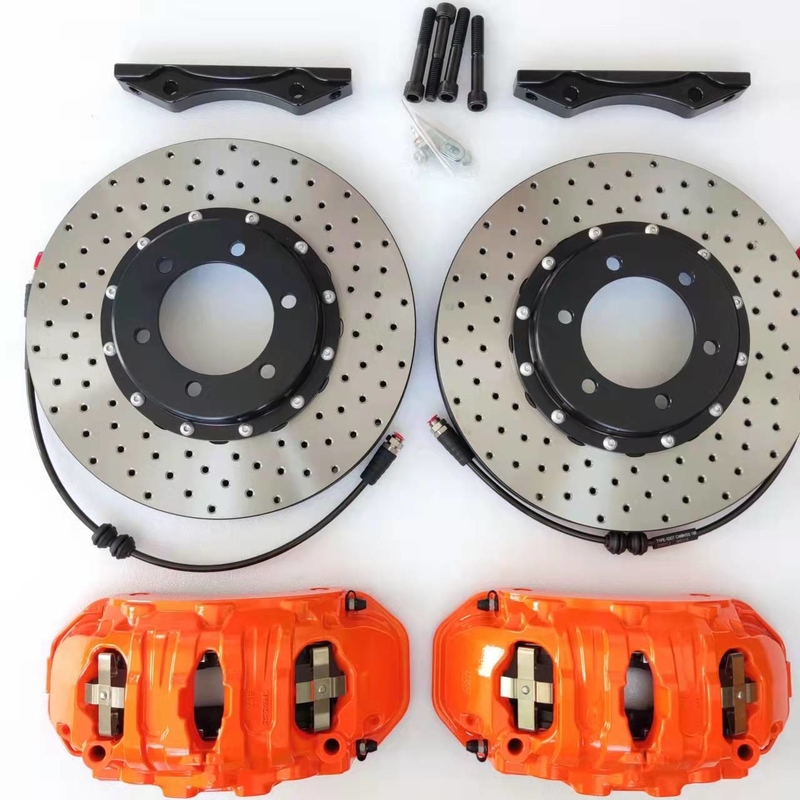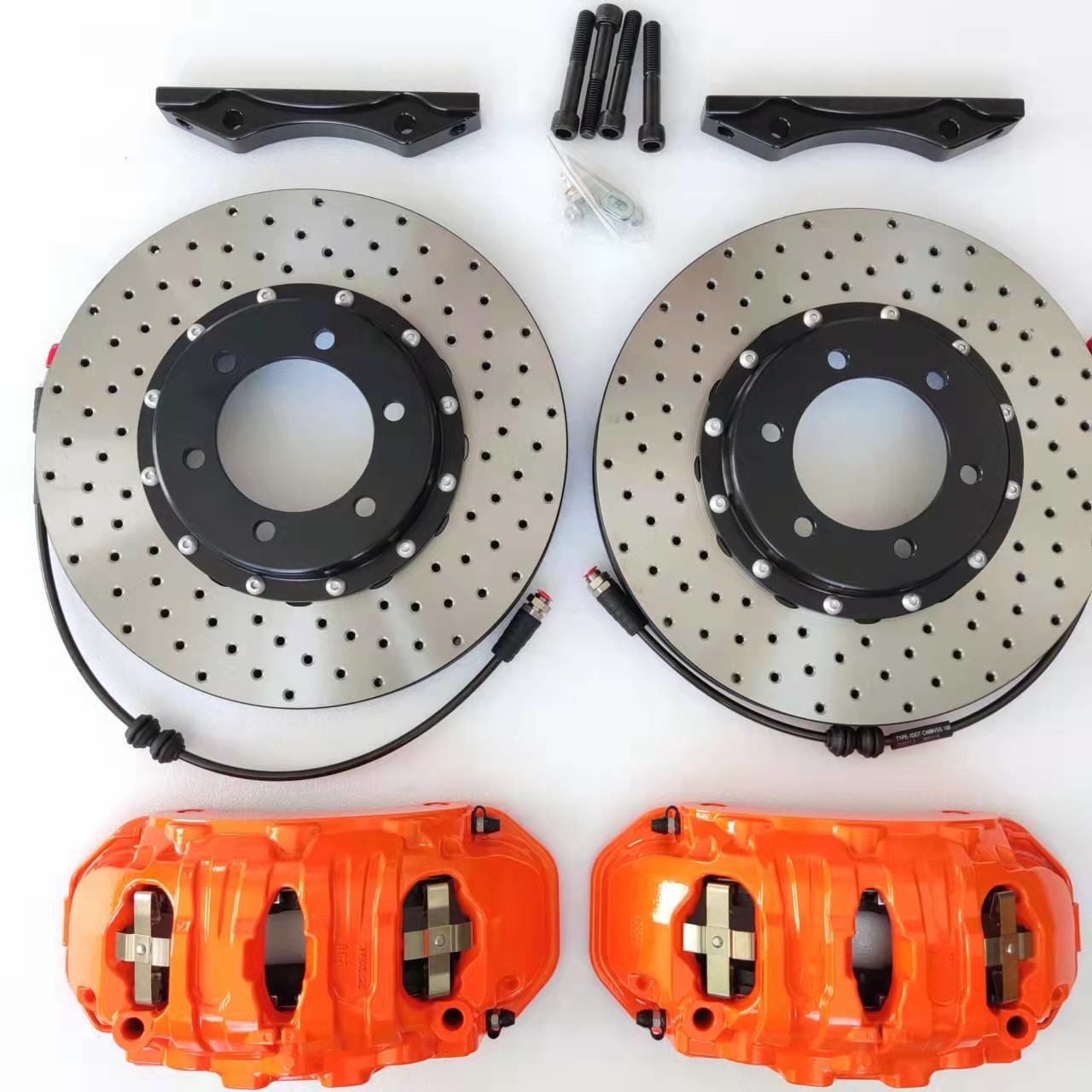Product Description
Orange 19Z calipers with 380x36 discs for Toyota fortuner front
Disc Brake
Brake rotors of disc brakes rotate with the wheels, and brake pads, which are fitted to the brake calipers, clamp on these rotors to stop or decelerate the wheels. sThe brake pads pushing against the rotors generate friction, which transforms kinetic energy into a thermal energy.
Brakes for Automobiles
Opposed Piston Type Disc Brakes
This thermal energy generates heat, but since the main components are exposed to the atmosphere, this heat can be diffused efficiently. This heat-dissipating property reduces brake fade, which is the phenomenon where braking performance is influenced by the heat. Another advantage of disc brakes is its resistance to water fade, which occurs when the water on the brakes significantly reduces braking force. When the vehicle is in motion, the rotor spins at high speeds and this rotational motion discharges the water from the rotors themselves, resulting in stable braking force.
| Material |
HT250 |
| Life time |
60000-80000kms; |
| Certification |
ISO9001/TS16949 |
| Package |
Box+carton+pallet; |
| Port |
Qingdao or others; |
| QC |
1.Sample check;
2.Before production, mould and model check;
3.Technicians self check in production;
4.Engineer spot check;
5.Packing check;
6.Check before shipping.
|
Getting to Know Brakes|Products and Technologies
Disc brakes are generally used in passenger cars, but due to their stable performance at higher speeds and resistance to brake fade, they are gradually spreading into the commercial vehicle segment, where drum brakes were traditionally chosen for their longer service life. There is increasing demand from customers for longer service life and higher quality, and Akebono is committed to meeting them through further development of the disc brake’s reliability. There are two types of disc brakes.
The "opposed piston type disc brake" has pistons on both sides of the disc rotor, while the "floating type disc brake" has a piston on only one side. Floating caliper type disc brakes are also called sliding pin type disc brakes.
Disc brake construction
The brake rotor (disc) which rotates with the wheel, is clamped by brake pads (friction material) fitted to the caliper from both sides with pressure from the piston(s) (pressure mechanism) and decelerates the disc rotation, thereby slowing down and stopping the vehicle.
How to choose the combination of front and rear brakes
1. Select according to hub size
J value and et value shall be considered at the same time. If the corresponding space of the hub is insufficient, it will interfere and cannot be installed. It is also forbidden to cut the caliper body / hub due to size problems, which is very dangerous.
2.Front wheel refitting idea
15 inch options: Street version 7600 and competitive version 9444
17 inch options: Street version 9200 / GT4 and competitive version 9440
18 inch optional: Street version 9040 9540 8530 / GT6 18Z AMG6 competitive version 9448 9660 9665 / GT4
Wheels over 19 inches can be selected: Street version 8520 8521 8522 / GT6 AMG6 GTS6 (referred to as 85 series, with different piston area of the same shape)
Street version 9560 9561 9562 (referred to as 95 Series, with different piston areas of the same shape)
3.Rear wheel modification idea (the front wheel shall be determined first, and then the corresponding ratio shall be made)
Front four pistons: 9200 8530 9540 rear two pistons: 5317
Front six pistons: 9040 / GT6 rear four pistons: 9202 / 7609 / GT4
Front six pistons: 8520 8521 8522 / GT6 AMG6 GTS6 rear four pistons: 8530 / 8540 / 8560 /GT4
Front six pistons: 9560 9561 9562 / GT6 AMG6 GTS6 rear four pistons: 9541 / 9542 / GT4
The collocation needs to follow the first six rear four front four rear two front big four rear small four (the car power needs to be distributed, and so does the braking force)
How to install the brake Kit
Step 1: clean the bearing. After removing the original brake system, clean the bearing part with a steel brush, remove the rust on it, and measure whether the bearing plane is deformed to ensure that the upgraded brake disc fits closely on the bearing.
Step 2: apply sound insulation adhesive to the bearing. Thin application of sound insulation glue on the bearing plane of the original factory can not only prevent the bearing from rusting, but also make the contact between the bearing and the brake disc closer.
Step 3: fix the brake disc. Place the brake disc on the bearing, but note that the screws in this part don't have to be tightened in a hurry. At this step, just fix it.
Step 4: install the axle code and caliper. After the brake disc is fixed, fix the bridge code on the sheep horn, and then fix the caliper on the bridge code to ensure the correct installation position of the bridge code, the correct installation direction of the bridge code and the correct installation direction of the caliper. This step is the same. There is no need to tighten the screws in a hurry, just fix them in a fixed position.
Step 5: accurate measurement of caliper position. In fact, this step is often the most easily overlooked, but it is also the most important step in the whole installation process. In the future use of many modified calipers, the uneven strength of left and right calipers, inconsistent wear of brake pads, and even brake jitter are related to this step. This step is to use an accurate vernier caliper to measure whether the caliper and the brake disc are accurately symmetrical up, down, left and right. On the premise of ensuring accuracy, the force pushed out by the piston can be evenly dispersed on the back of the brake pad, completely avoiding the problem of uneven left and right force, resulting in the failure of the caliper to work completely.
Step 6: tighten the screws correctly. After confirming the position of the caliper, the fixed screws need to be coated with screw glue. According to the requirements of the caliper manufacturer, use the correct torque wrench to fix the caliper screws. This is very important. Do not use an air cannon.
Step 7: install the brake pad + fixed pressing plate. The brake pads of different calipers are installed in different ways, so this step can also be advanced before the calipers are fixed. The more important thing here is to apply sound insulation glue, which can not only make the brake pads work more smoothly, but also reduce the probability of abnormal noise of the brake pads as far as possible. After installing the brake pad, the spring pressing plate at the top shall also be installed.
Step 8: installation of steel throat oil pipe. For refitting brakes, the importance of steel throat need not be said. It should be noted here that the steel throat with appropriate length shall be selected according to different models, and the steel throat with correct interface shall be matched according to the model of caliper.
Step 9: exhaust air from brake oil. This part is very important for the braking system. If the braking system contains air, it will lead to insufficient braking force at light level and loss of braking by directly depressing the pedal at heavy level. Here, I personally suggest using the special equipment for brake oil replacement to directly replace all brake oil. If the brake oil is very new, use the brake oil of the same brand and model to drain the pedal and replenish the oil.
Step 10: check oil leakage + confirm interference. After the air exhaust operation of brake oil, after a simple test run, stand for 30 minutes, and check whether there is oil leakage at the interface of brake oil pipe again. Once it is found, it must be handled immediately and the air exhaust operation must be carried out again. In addition, after lifting the car, turn the wheels left and right respectively, and observe whether there is any movement interference between brake calipers, bridge codes, screws, oil pipes and other parts, so as to ensure that there is no friction between these key parts and any parts of the body, and the oil pipes are not pulled. Only in this way can we ensure driving safety in the future.
RFQ
If you need a complete modified caliper kit,Please contact customer service
Please provide:
1. What Car? What year?
2. Wheel hub size? For example, 18-inch 19-inch
3. Modified wheel hub or original wheel hub?
4.Can you give me the Chassis number or frame number(VIN number)?
The above information is used for accurate recommendation of products and accurate quotation
 Your message must be between 20-3,000 characters!
Your message must be between 20-3,000 characters! Please check your E-mail!
Please check your E-mail!  Your message must be between 20-3,000 characters!
Your message must be between 20-3,000 characters! Please check your E-mail!
Please check your E-mail!
